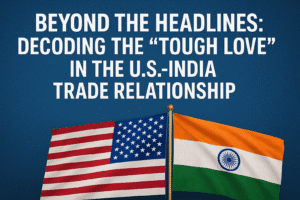Beyond the Headlines: Decoding the “Tough Love” in the U.S.-India Trade Relationship
Amid a significant trade dispute marked by U.S. tariffs exceeding 50% on Indian goods, a U.S. Congressman has framed the tension as a sign of respect rather than deterioration. This perspective suggests that the United States, confident in the relationship’s strength, is applying pressure to secure greater strategic alignment from India on issues like Russian oil. While India has condemned the tariffs as unjust and a threat to its key industries, the underlying fundamentals of the partnership remain robust.
These include deep people-to-people connections, shared democratic values, and a mutual goal of enhanced military cooperation. The current friction is thus interpreted not as a breakdown, but as a difficult yet inevitable negotiation between two powerful allies recalibrating their expectations. The prevailing outlook is one of optimism, anticipating that both leaders will navigate these challenges to forge a stronger, more integrated alliance.

Beyond the Headlines: Decoding the “Tough Love” in the U.S.-India Trade Relationship
In the high-stakes world of international diplomacy, a trade war is rarely a sign of deep respect. Yet, that is precisely the paradoxical message emanating from Washington, as conveyed by U.S. Congressman Michael Baumgartner to NDTV. Amid a tense tariff row that has seen U.S. duties on Indian goods soar above 50%, the Congressman asserted that President Trump “respects India and PM Modi a lot.”
This statement begs the question: what does “respect” look like in the realm of modern geopolitics, and how should we interpret the current friction between the world’s oldest and largest democracies?
The Strategic Calculus Behind the Conflict
The current strain is not born of a single issue but a confluence of strategic disagreements. The immediate trigger was the U.S. imposition of secondary tariffs on India for its continued purchase of Russian oil—a move by the Trump administration to enforce its foreign policy goals. Reports also suggest frustration in Washington over India’s rejection of a U.S. peacemaking role in its recent tensions with Pakistan.
From the Indian perspective, these tariffs are, as New Delhi stated, “unfair, unjustified, and unreasonable.” For sectors like textiles and marine exports, which form the backbone of numerous livelihoods, the economic impact is direct and painful. Prime Minister Modi’s strong rebuttal, vowing never to compromise the interests of Indian farmers and fishermen, frames this not as a mere trade dispute, but a matter of national principle.
The “Asking More of Friends” Doctrine
Congressman Baumgartner’s explanation provides the crucial lens through which Washington views this conflict. His comment, “sometimes you have to ask more of your friends,” is less a diplomatic platitude and more a revelation of a core strategic philosophy.
This approach suggests that the U.S. feels a level of confidence in its relationship with India that allows for hardball tactics—a privilege not afforded to less stable partnerships. The underlying message is: “We believe our bond is strong enough to withstand this pressure, and we need you to align more closely with our strategic interests.” It’s a form of tough love, where economic pressure is a tool to compel geopolitical alignment, particularly regarding Russia and China.
This interpretation transforms the tariffs from an act of aggression into a brutal acknowledgment of India’s elevated importance on the world stage. The U.S. is no longer treating India with kid gloves because it expects—and demands—more.
The Unshakable Fundamentals
Despite the fiery rhetoric and economic posturing, both officials and analysts point to the “strong fundamentals” that continue to underpin the relationship. Baumgartner highlighted several irreplaceable pillars:
- People-to-People Ties: The immense success and contribution of the Indian-American community and Indian students in the U.S. create a deep, organic bond that transcends administrative policy.
- Military Integration: The long-term goal of increased military collaboration and interoperability remains a shared objective for countering common threats and ensuring regional stability.
- Shared Democratic Values: This foundational element, while often tested, provides a common language and a framework for resolving disputes that does not exist in relationships with non-democratic nations.
The Path Forward: Negotiation, Not Erosion
The consensus, as echoed by the Congressman, is one of cautious optimism. The belief is that President Trump, the self-proclaimed “deal-maker,” and PM Modi, a seasoned leader with a strong mandate, will eventually negotiate a resolution. The current “bumps” are seen as an inevitable part of recalibrating a complex and maturing partnership.
The real insight for observers is to look beyond the headlines of tariff percentages and diplomatic condemnations. The current tension is not a symptom of a relationship in decline, but rather a sign of its evolution. It is the difficult and often messy process of two powerful, proud nations moving from a comfortable partnership to a more integrated and strategically aligned alliance—one where expectations are higher and the stakes are even higher.
The coming weeks will test the resilience of these ties, but the underlying message from both sides is clear: the foundation is too critical to fail. The respect isn’t just rhetorical; it’s the very reason the demands are so high.
You must be logged in to post a comment.